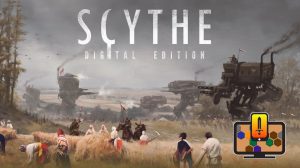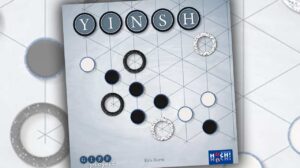Disclosure: Meeple Mountain received a free copy of this product in exchange for an honest, unbiased review. This review is not intended to be an endorsement.
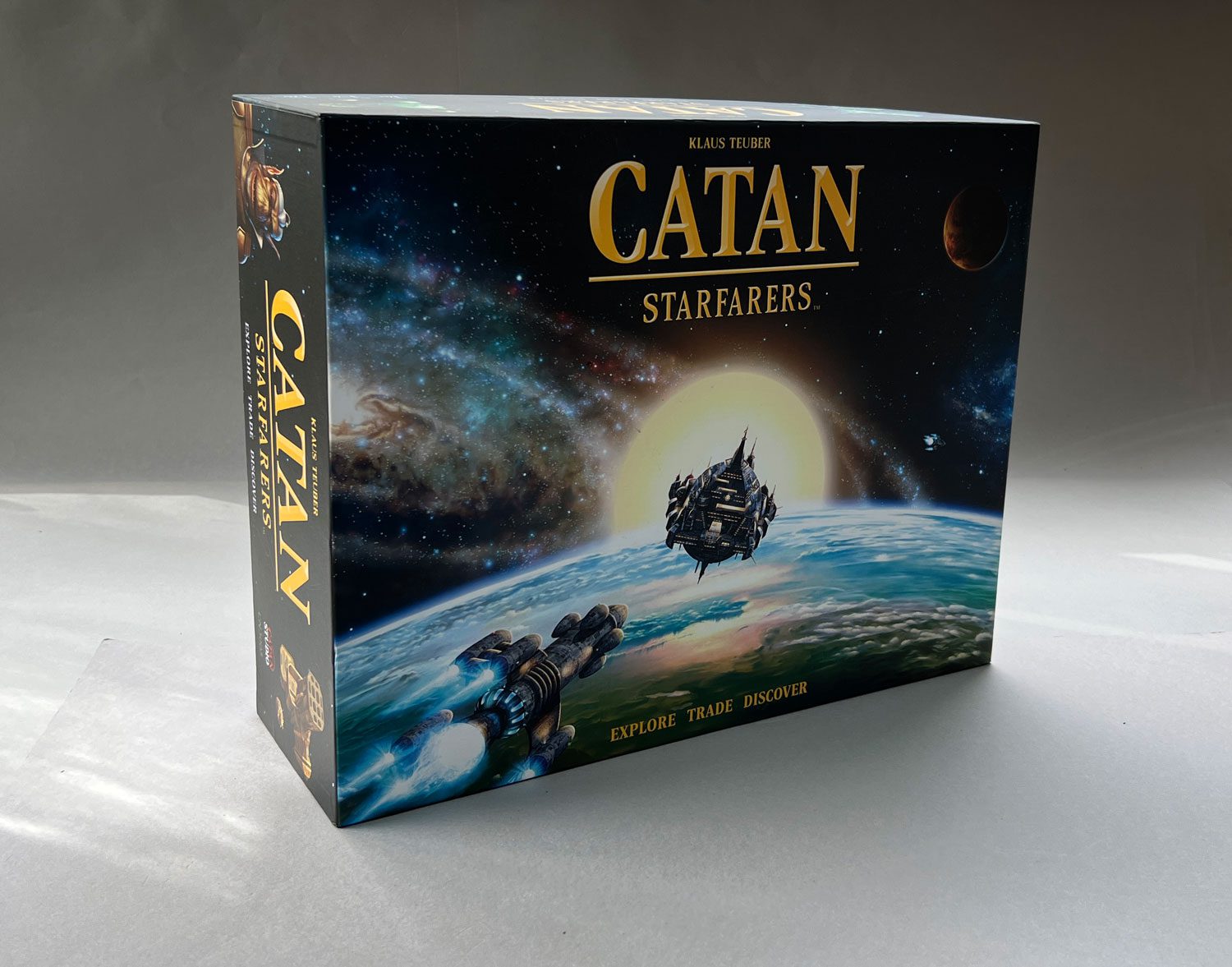
In 1995, Klaus Teuber introduced Settlers of Catan, to the world. It won the Spiel des Jahres that year and, without a trace of hyperbole, changed board gaming forever.
Four years later, Teuber launched his game into outer space with The Starfarers of Catan. This version included a much larger board with planetary systems, new resources to gather, and one large rocket per player. Unfortunately, the production aspects let the game down. The rocket and the pieces that attach to it often broke through repeated play. As a result, Starfarers disappeared from shelves, leaving a mixed legacy behind.
In the years since then, Settlers of Catan has been renamed Catan with many, many expansions. People like me, who had long heard of Starfarers as being better than standard Catan, waited patiently for a Starfarers reprint. In 2019, that reprint finally hit the stores. It came with improved plastic pieces and a modular board.
But, is Catan: Starfarers really any good? And could it possibly be better than Catan?
Let’s get it to the table to see for ourselves, shall we?
Setup
You’ll start by building the game board. It comes in six 11” x 11” puzzle pieces that, once assembled, will have a number of empty spaces you’ll fill in with matching pieces, face side down.
The game’s Almanac has a suggested first game setup, including which Planetary Systems (the matching pieces to the empty spaces) go where, as well as positions for each player’s starting pieces at the base of the board. We followed it and found it led to a well-balanced first game, but then varied the set up for subsequent games.

The planets in each Planetary System have a symbol on them. Find the matching discs and place them, symbol side up, on each planet. Set all the other discs off to the side.
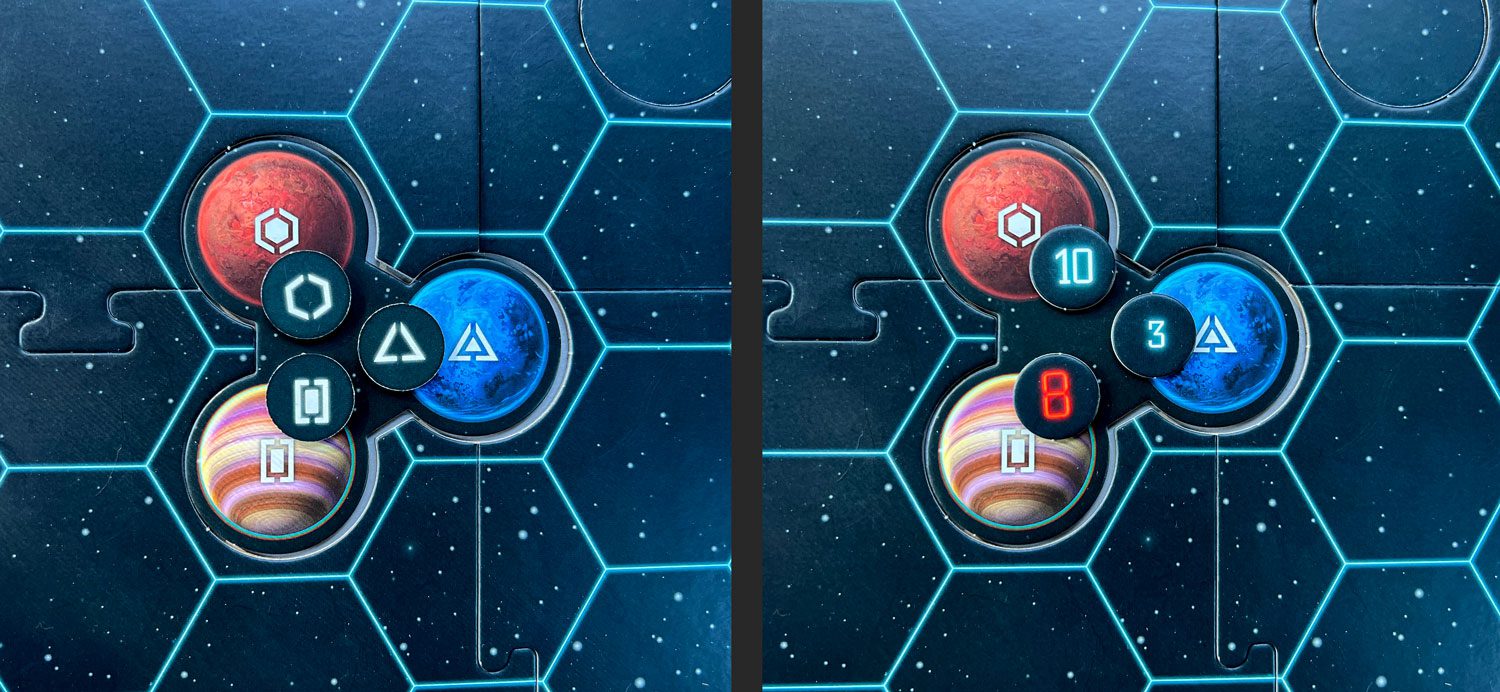
Place all the resource cards into the included tray, making sure the Goods cards go in the slot marked 2:1. The other cards are each in slots for 3:1, meaning they can be traded in for other cards throughout the game at that exchange rate. Take eight cards from each resource, shuffle them together, and place them in the open slot in the tray. Deal three cards from this deck to each player.
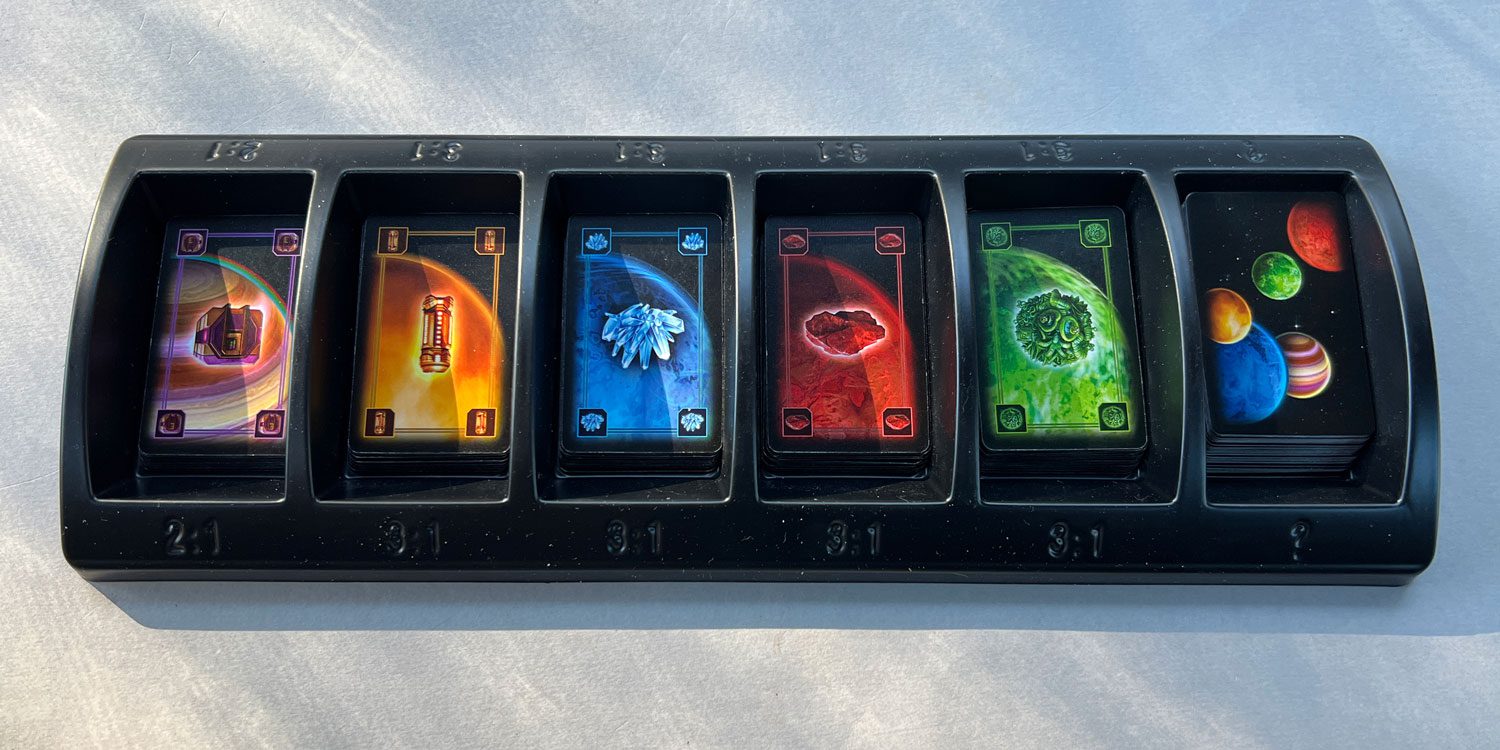
Another tray is included to hold the various rocket upgrades (Booster, Freight, and Cannon) and the broken Fame pieces. Shuffle the deck of Encounter cards and place them in the large opening at the end of that tray.
Sort the Friendship cards into their four separate decks and place them to the side of the board. Set the matching stand-up tokens next to each deck.
Each player then chooses a color and takes all the pieces of that color. This includes Colonies (large hex pieces), Trade Stations (smaller hex pieces), Shipyards (hex rings that fit around the Colony pieces), and Transport Ships (tiny rocket ships). Place the round score markers on the number 4 on the board. The first player to reach 15 points wins.
And then there’s the Rocket.

Let’s face it: as game components go, these rockets are pretty cool.
If it’s your first time playing, carefully twist off the top of your rocket and drop in 2 yellow, 1 blue, 1 red, and 1 black small plastic balls. Then replace the top of the rocket. Go ahead and give it a shake. (You know you want to!)
Take one of the orange boosters from the rocket upgrades tray and add it to the bottom of one of the three rocket fins. Then everyone gets one half of a fame token. (Two token pieces = 1 point)
Choose a starting player, and the game can begin.
Playing the Game
If you know how to play Catan, you’ll be familiar with most of how Starfarers plays.
On a turn, you’ll roll two dice, take the total, and match that number with numbers showing on the planets. Players with a Trade Station, Colony, or Spaceport adjacent to the number, collect a resource that matches the planet’s color. Following that, the active player can trade resources with other players and/or trade in resources to upgrade your rocket or build Spaceports, Colonies, or Ships.
If you roll a seven in Starfarers, anyone with more than seven resource cards in their hand has to discard half their cards, rounded down.
The additional action in Starfarers also involves shaking your rocket. In the Movement phase, you’ll total the number of the shown balls. That number indicates how many corners of the hexes across the board you can move each of your Ships across the vastness of space.
However, if one of those balls is the black one, no movement takes place. Instead, the player to your left draws the top Encounter card from the deck and reads the topmost part aloud.
Many Encounter cards involve scenarios (“You encounter a trader…” or “You encounter a space pirate…”) that require you to make a choice. If, for instance, you choose to do battle with a space pirate, you and another player will shake your rockets and compare the total of the small, plastic balls that appear in the base (red = 3; yellow = 2; blue =1; black = 0). The Encounter card will explain the results and consequences.
Exploration
As you move into space, you may choose to come in contact with those Planetary Systems I mentioned before. When landing on an intersection adjacent to one, you’ll turn over all three of the discs to their face up side. Some of these will be numbers, indicating they will generate resources if a Trade Station, Colony, or Spaceport is placed at the adjoining intersection.
Some discs may show either an Ice Planet or a Pirate Base. In that case, the planetary intersections with those markers are off-limits until they are resolved. In the case of an Ice Planet, one of your ships must be adjacent to it and your rocket must be equipped with Freight Pods equal to or greater than the number on the disc. With a Pirate Base, your rocket must have a number of cannons equal to or greater than the number shown.
When Terraforming an Ice Planet or defeating a Pirate base, you’ll first claim the token on the planet and score one point. You’ll then replace it with a disc with the same symbol, placing it face up so the number is visible.
Making Friends
The board is also populated with four Outposts. Each Outpost has a central docking point and spaces where Trade Stations can be placed. As a sign of goodwill, when you do so, you’ll be able to select one of the bonus cards from that alien race. All these cards grant you a special power for the rest of the game.
The first player to reach an Outpost also claims a Friend token for that race, worth one point. That friend token remains yours unless another player places more Trade Stations at the Outpost than you have. If so, the other player claims the Friend. You’ll lose a point and they’ll gain one.
Thoughts
Catan: Starfarers has many things to recommend itself. Let’s start with learning the game.

The player aides for Starfarers are as near to perfect as I’ve seen. Even if you’re not familiar with the Catan system, the cards are easy to read. They explain player turns and show the resources needed to upgrade your rocket and build a Trade Station, Colony, or Spaceport.
Like Catan, Starfarers comes with a Rulebook and an Almanac. The rulebook covers the basic rules and goes into detail about the possibilities of a given turn. The Almanac is an alphabetical listing of all the elements of the game, with the particulars of each part of the game. If you have a question, it’s going to be answered in one (if not both) of these guides.
Between the number of planets in the various Planetary Systems, the chance to gain resources is much greater in Starfarers. More resources means a greater possibility of trades. Also, the standard trading with the game is 3:1 (as opposed to Catan’s 4:1). We still found a scarcity of certain resources, but there were more chances to either build spacecraft or augment our rockets throughout the game.
I’m sure some people may disagree with this, but I welcomed the lack of Development cards from Catan in Starfarers. Development cards in Catan are a hidden element to the game, ones that can be sprung on you just as you move closer to victory. I’ve never been a big fan of those cards, and not having them is a big plus for me. It keeps Starfarers an open-information game, which is more my preferred playing style.
On the negative side, Starfarers takes considerably longer to play than standard Catan. Where our last three-player game of Catan took about an hour playing Starfarers with the same player count took close to 2.5 hours. (Our first four-player game, played with people who were very familiar with Catan, took 3.5 hours.)
Despite the increased access to resources, only sticking with your starting resources will not be enough. Therefore, you’re going to need to build spacecraft and move them across the board to other planets. While both games are played within a contained field, Starfarers’ field is many times larger than Catan’s.
Encounter cards frequently bring the game to a stop (again, these are drawn when a black ball appears at the base of your rocket), interrupting the flow of play. Adding to this frustration, many of the Encounter cards are duplicates. With the attention to detail the production crew gave the rest of the game, the repetition of these frequently drawn cards just doesn’t make sense. It became something of a joke whenever an Encounter card was drawn, with people around the table saying, “You encounter a trader…” before the card was even read.
If there had been a greater variety of Encounters, they would have been approached with some degree of caution. As it was, even the worst of outcomes were merely slightly annoying and hardly worth the effort.
Coming back to the questions I asked at the start of this review, “Is Catan: Starfarers really any good?” Yes, it is. With Starfarers Teuber took the concepts of its predecessor and transformed it into an expansive adventure.
That leaves me with, “Could it possibly be better than Catan?” For me, Starfarers is better than Catan. I realized during my first playthrough that I was having more fun with Starfarers than I had had with Catan for a long time. It wasn’t just because of the gimmicky rocket or the new components, it was because the openness of the board required exploration, and with it, new things to discover.
During a recent game of standard Catan, I realized something else: in Starfarers, I was able to actively improve my position on every turn. In Catan, you roll two dice. You might get a resource, you might not. Then you pass the dice to the next player. I’ve played too many games of Catan where the needed numbers don’t show up for too many turns, meaning I have to sit and wait.
In Starfarers, you’re able to move your Transport Ships further into space on every turn. That sense of agency is a fundamental change for the better. We’re in space, and we’re exploring it on every turn, just as you’d expect to.
If you like Catan, I recommend you seek out Catan: Starfarers. I think you’ll catch on to the differences quickly and, despite the added time, find that Starfarers is a more enjoyable game.




